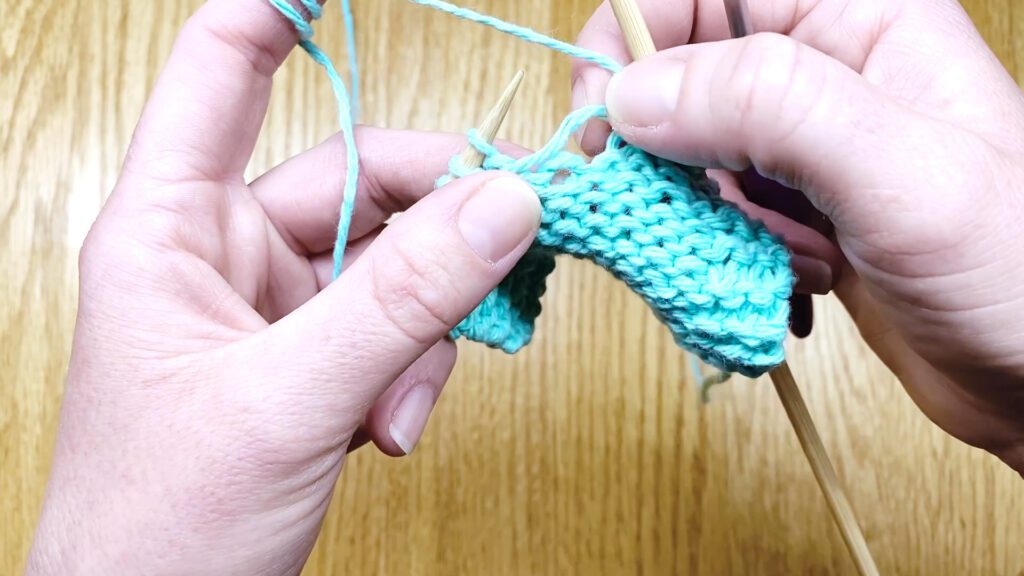
As you knit, you will often find yourself coming to the end of a ball of yarn without your project being finished. This will be especially true with larger knitted pieces, like scarves and blankets. When your ball of yarn runs out, or if you find a break in the yarn you have been working with, you can use a simple knotting technique, commonly referred to as a “magic knot,” to join new yarn to your working yarn. While there are other ways to join yarn, I find this knot to be the strongest and most versatile way to accomplish the task.

You can join new yarn by simply knitting it into the net stitch in your pattern. This technique, however, leaves you with extra yarn tails to weave into the project. Using a magic knot to tie the two ends together lets you continue working without making additional loose ends.
A magic knot is created by tying two small knots, which tighten against one another when the string is pulled or stretched. The knot becomes stronger the more you pull on the two ends of yarn. Because the magic knot isn’t bulky, it blends the two ends of yarn together almost invisibly
Below you will find both video and written guides to help you learn how to add new yarn to your knitting project.
A Note About Yarn Color
In the following instructions, you will see two separate colors of yarn being tied together. This is meant to distinguish the ends as you learn. Usually, however, you will use a new ball of yarn in the same color with which you have been working.
Video Guide: How to Join New Yarn
Written Guide: How to Join New Yarn with a Magic Knot

Magic Knot, Step 1:
Arrange your yarn so that the new yarn ball is on your left and the knitting project is on your right. Lay the two yarn ends parallel to one-another, with the tails pointing in opposite directions. Place the new yarn tail at the bottom and the old yarn tail at the top.

Magic Knot, Step 3:
Lift the old yarn slightly and bring the new yarn end down and under the old yarn.

Magic Knot, Step 4:
Next, bring the tail of the new yarn up so that it crosses over itself and forms a loop around the old yarn.

Magic Knot, Step 5:
Tuck the tail of the new yarn through the loop you just made, ensuring the end of the new yarn is pointing toward the right (toward your knitting project).

Magic Knot, Step 7:
Pull both ends of the new yarn to tighten the knot onto the old yarn. Ensure the old yarn remains in the same position in which it started.

Magic Knot, Step 10:
Lift the new yarn slightly and bring the old yarn end up and under the new yarn.

Magic Knot, Step 11:
The old yarn tail should cross under itself to form a loop around the new yarn. Pick up the old yarn tail while keeping open the loop you have just created.

Magic Knot, Step 12:
Tuck the tail of the old yarn through the loop, ensuring the end of the yarn is pointing leftward, toward your new ball of yarn.

Magic Knot, Step 13:
Pull both ends of the old yarn to tighten the knot onto the new yarn. Ensure the new yarn remains in the same position in which it started.

Magic Knot, Step 14:
Once the two knots have been secured, pick up the new yarn strand on your left and the old yarn strand on your right. Pull the two strings in opposite directions; this will cause the two knots to start slipping toward each other.

Magic Knot, Step 15:
When the two knots meet, pull hard on the yarn ends to check that the knots tighten against one another and do not slip.

Magic Knot, Step 16:
When you are certain your knot is tight, clip the two loose ends away from the knot with very sharp scissors.

Magic Knot, Step 17:
Check the strength of your knot once more by pulling the new and old yarn ends in opposite directions. If your knot is made correctly, it will not come undone.
Practice With My Knitting Patterns

My free Rice Stitch Blanket pattern uses several balls of yarn. Try out your magic knot on this project.

You can also practice joining new yarn when knitting my free Slipped Stitches Scarf.

Up Next

Some patterns will ask you to change the needle size with which you’ve been knitting. Let’s learn how to switch needle sizes as you work on a flat knitted project next.























































































